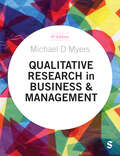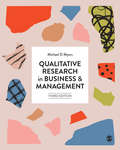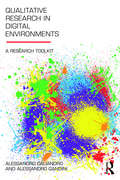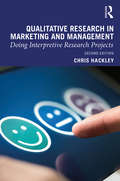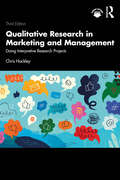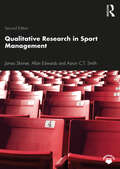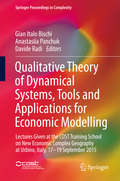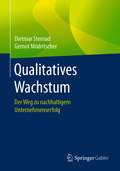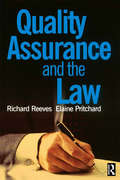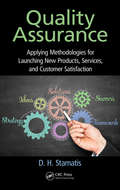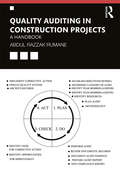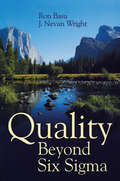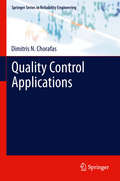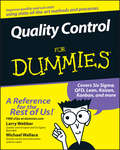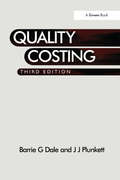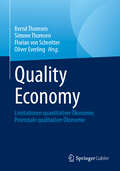- Table View
- List View
Qualitative Research in Business and Management
by Michael D MyersThis accessible, comprehensive yet remarkably concise textbook is designed to help students and researchers in business and management with their research project. It covers key qualitative research methods, data collection techniques and explores how to analyse qualitative data, before providing invaluable advice on how to write up your research and get published. Now in its fourth edition, Qualitative Research in Business and Management has been updated to reflect the growing popularity of online research and secondary data collection, with new content on AI, the digitalization of qualitative research and virtual fieldwork. Michael D. Myers is Professor of Information Systems in the Department of Information Systems and Operations Management at the University of Auckland Business School, Auckland, New Zealand.
Qualitative Research in Business and Management
by Professor Michael D MyersThis accessible and expansive, yet remarkably concise textbook is designed to help readers with their research project. As well as guiding them through the key methods of collecting and analysing qualitative data, this book provides invaluable information on writing up their research and how to get published. Now in its third edition, Qualitative Research in Business and Management has been fully updated to include a range of recent examples of aspects of qualitative research in action, and a new look at the methods and ethics of using social media data.
Qualitative Research in Business and Management
by Professor Michael D MyersThis accessible and expansive, yet remarkably concise textbook is designed to help readers with their research project. As well as guiding them through the key methods of collecting and analysing qualitative data, this book provides invaluable information on writing up their research and how to get published. Now in its third edition, Qualitative Research in Business and Management has been fully updated to include a range of recent examples of aspects of qualitative research in action, and a new look at the methods and ethics of using social media data.
Qualitative Research in Digital Environments: A Research Toolkit
by Alessandro Gandini Alessandro CaliandroThis book offers a toolkit of methods and technologies to undertake qualitative research on digital spaces. Unlike commonly used traditional methodological strategies, which are ‘retrofitted’ to digital spaces, Qualitative Research in Digital Environments offers researchers a set of ‘digitally native’ tools that are designed for online social environments. Thanks to a broad range of cases including Louis Vuitton, YouTube and the concept of ‘hipsterism’, this text illustrates the practical applications of techniques and tools over the most popular social media environments. This book will be a valuable guide to qualitative research for marketing students, researchers and practitioners, as well as a central reference point for tutors in the growing field of Digital Sociology.
Qualitative Research in Marketing and Management: Doing Interpretive Research Projects
by Chris HackleyThis is a practical and accessible, yet sophisticated introduction to interpretive methods for doing qualitative research projects and dissertations. Bringing together concepts of qualitative research from ethnography, phenomenology, critical discourse analysis, semiotics, literary analysis, postmodernism and poststructuralism this textbook offers an accessible and comprehensive introduction to the subject. Utilising a uniquely pragmatic approach, it bridges the gap between advanced, specialised books on research traditions with more general introductory business research books. This new edition has been fully updated to include new examples, explorations of the field, and an improved pedagogy with better exposition of key issues and concepts, as well as more schematics and diagrams to aid understanding. The first half of the book considers the practicalities of research and writing a research project, including the craft of academic writing, the critical literature review, the role of the independent research project as part of university courses, suggested projected structures, standards of academic scholarship, and the main techniques for gathering qualitative data. The book’s second half deals with abstract concepts and advanced theory by looking at key theoretical traditions that guide the interpretation of qualitative data. It is perfect for advanced undergraduate and postgraduate students of marketing, management, consumer behaviour and research methods. It will also be useful as a primer for practitioners in qualitative research.
Qualitative Research in Marketing and Management: Doing Interpretive Research Projects
by Chris HackleyThis is a practical and accessible introduction to interpretive methods for doing qualitative marketing and management research projects.Bringing together concepts of qualitative research from ethnography, digital ethnography, phenomenology, assemblage theory, critical discourse analysis, semiotics, literary analysis, practice theory, postmodernism, poststructuralism and other areas, it has a uniquely pragmatic approach. The book bridges the gap between advanced, specialised books on research traditions with more general introductory business research books. The first half of the book considers the practicalities of research and writing a research project, including the craft of academic writing, the critical literature review, the role of the independent research project as part of university courses, suggested projected structures, standards of academic scholarship, and the main techniques for gathering qualitative data. The book’s second half deals with abstract concepts and advanced theory by looking at key theoretical traditions that guide the interpretation of qualitative data. This third edition has been fully updated to include new examples, insights from recent research, and an improved pedagogy for logic and clarity throughout, as well as more graphics, diagrams, chapter summaries and exercises to aid understanding.It is perfect for advanced undergraduate and postgraduate students of Marketing, Management, Consumer Behaviour and Research Methods.Online resources include PowerPoint lecture slides.
Qualitative Research in Sport Management
by James Skinner Allan Edwards Aaron C.T. SmithGood qualitative research can help sport management researchers and industry professionals solve difficult problems and better understand their organisations, stakeholders and performance. Now in a fully revised and extended new edition, this book is a user-friendly introduction to qualitative methods in sport management. Covering the full research process from research planning to reporting results, this edition includes expanded coverage of cutting-edge areas including digital and social media research, critical realism, and social network analysis. The book examines the reflective and interrogative processes required for developing effective qualitative research questions and includes a deeper discussion of ontology and epistemology in the light of today’s rapidly changing society. It takes the reader step-by-step through essential and emerging qualitative methods, from actor network theory and ethnography to computer-assisted data analysis and sampling typologies. Every chapter includes examples of real qualitative research, including shorter "research briefs" and extended case studies, reflecting the exciting qualitative research that is currently occurring in sport business and management, and highlighting the links between research and sport management practice. This is essential reading for courses in sport management, sport business, sport policy, sport marketing, sport media, and communications. It provides students, researchers, and practitioners with the knowledge and skills to undertake qualitative research while deepening their understanding of how the social world can be perceived and interpreted through a particular theoretical lens. Useful online materials include recommended readings and PowerPoint slides.
Qualitative Research in Sport Management
by James Skinner Allan EdwardsQualitative Research in Sport Management is the first book of its kind to bring together valuable research designs based on extensive research in qualitative research methods across a number of different fields. Research designs from the fields of business, education, cultural studies, media studies, queer studies, sociology and psychology are applied specifically to sport management, taking into account the special features and nuances of this field. In each research design the text provides a concise guide to how each model can first be applied to sport management issues and problems, second, strengthen the research design, and finally, enhance the research process. Each chapter is carefully structured to ensure that key information is easy to locate and remember and includes: Introduction, Objectives, Key Concepts and Terms, and Review and research questions. International case studies, "In Profile" sections with leading sport management researchers and research briefs are used to illustrate how theory is put into practice. An accompanying website provides powerpoint summaries of each chapter. Please visit: www.textbooks.elsevier.com/9780750685986.
Qualitative Theory of Dynamical Systems, Tools and Applications for Economic Modelling
by Gian Italo Bischi Anastasiia Panchuk Davide RadiThe book presents the lectures delivered during a short course held at Urbino University in summer 2015 on qualitative theory of dynamical systems, included in the activities of the COST Action IS1104 "The EU in the new economic complex geography: models, tools and policy evaluation". It provides a basic introduction to dynamical systems and optimal control both in continuous and discrete time, as well as some numerical methods and applications in economic modelling. Economic and social systems are intrinsically dynamic, characterized by interdependence, nonlinearity and complexity, and these features can only be approached using a qualitative analysis based on the study of invariant sets (equilibrium points, limit cycles and more complex attractors, together with the boundaries of their basins of attraction), which requires a trade-off between analytical, geometrical and numerical methods. Even though the early steps of the qualitative theory of dynamical systems have been in continuous time models, in economic and social modelling discrete time is often used to describe event-driven (often decision-driven) evolving systems. The book is written for Ph. D. and master's students, post-doctoral fellows, and researchers in economics or sociology, and it only assumes a basic knowledge of calculus. However it also suggests some more advanced topics.
Qualitative und quantitative Eigenkapitalanforderungen: Theoretische Beiträge zur aktuellen Bankenregulierung
by Stefan MayerNach der globalen Finanzkrise 2007/08 herrschte die Handlungsmaxime: Banken müssen mit mehr Eigenkapital ausgestattet sein und dieses Eigenkapital muss von besserer Qualität sein. Dass das Eigenkapital einer Bank sowohl einen quantitativen als auch qualitativen Aspekt haben kann, ist ein besonderes Phänomen der Bankenregulierung. Denn das Eigenkapital einer Bank ist nichts Physisches, sondern ein Residualbetrag. Das Eigenkapital einer Bank kann erst nach Verkauf aller Aktiva und Befriedigung aller Passiva mit Sicherheit bestimmt werden. In der Bankenregulierung existiert ein Vielfaches an Eigenkapitalanforderungen. Diese beziehen sich mehr auf den quantitativen oder auf den qualitativen Aspekt von Eigenkapital. Während regulatorische Anforderungen hinsichtlich des quantitativen Aspekts vielfach untersucht wurden, weist der Stand der Forschung auch mehr als eine Dekade nach der Finanzkrise keine systematische Untersuchung zur Regulierung der Qualität des Eigenkapitals von Banken auf. Diese Untersuchung schließt diese Lücke.
Qualitatives Wachstum: Der Weg zu nachhaltigem Unternehmenserfolg
by Dietmar Sternad Gernot MödritscherDieses Buch beinhaltet einen grundlegend neuen Denkansatz zum Unternehmenswachstum. Es beschreibt Grundprinzipien, Strategien, Methoden und Instrumente zur qualitativen Weiterentwicklung von Unternehmen. Weit über den üblichen Rahmen klassischer Qualitätsmanagementsysteme hinaus wird ein ganzheitlicher Ansatz vorgestellt, mit dem Unternehmen in einer Kombination aus deutlichen Qualitätssprüngen und einer systematischen Weiterentwicklung wettbewerbsfähigere Qualitäts- und Leistungsniveaus erreichen können. Fallstudien aus der Unternehmenspraxis verdeutlichen anschaulich, wie sich wesentliche Handlungsfelder für qualitatives Wachstum identifizieren sowie gezielte Entwicklungsmaßnahmen einleiten und umsetzen lassen, um gleichzeitig bessere Leistungsangebote, nachhaltigen wirtschaftlichen Erfolg und positive Auswirkungen auf Umwelt und Gesellschaft zu erreichen.
Qualities of an Adaptive Organization: How Does Your Organization Measure Up?
by Alexander Grashow Marty Linsky Ronald HeifetzDiagnosing the organizational system, the adaptive challenge at hand, and the political landscape in an enterprise takes time, careful thought, and courage. You have to improvise creatively and responsively as you engage stakeholders inside and across the boundaries of your organization. Some organizations have the keen external sensors, internal norms, and a critical mass of people to do this. What distinguishes these enterprises? What makes some organizations more adaptive than others? In this chapter, the authors identify the characteristics that make some organizations more adaptive than others and offer a worksheet that will help you assess how well your organization stacks up. This chapter was originally published as chapter 7 of "The Practice of Adaptive Leadership: Tools and Tactics for Changing Your Organization and the World."
Quality Assessment and Enhancement in Higher Education in Africa (Routledge Contemporary Africa)
by Peter Neema-AbookiThis book explores quality assessment and enhancement in higher education in Africa to illustrate the need to develop quality practices in measuring effective education and continually search for permanent improvement. The book demonstrates that technological and socio-economic trends, innovations, and inventions of the twenty-first century demand that additional attention be placed upon education for national, regional, and international development. Since conventions for quality assessment and enhancement need to be defined and systematic structures constructed to develop quality practices, the book shows how quality in higher education within Africa has been established and advanced to provide a framework for monitoring, auditing, and reviewing assessment and enhancement. Though the book considers African complexities and diversity, it incorporates global trends and utilises an international focus that enables readers to devise appropriate strategies for developing and enhancing quality and standards in higher education in both continental Africa and beyond. Illustrating why quality assessment and enhancement should be embraced in all aspects including inputs, processes, outputs and outcomes in educational settings globally, this book will be of interest to policymakers and scholars in the fields of Higher Education, Quality and Global Studies, African Education, African Studies and Management and Administration, Leadership and Professional Development Studies.
Quality Assurance and Certification in Ecotourism
by Rosemary Black Alice CrabtreeThis book explores solutions to the problems of inconsistency and even exploitation of the term ecotourism through examples, case studies and a discussion of quality control and certification.
Quality Assurance and the Law
by Richard Reeves Elaine PritchardOver the last 25 years there has been a considerable increase in the awareness of quality related issues. In the world of business and commerce, this awareness has manifested itself in the development of what was the British Quality Standard BS 5750 into what is now the international standard BS EN ISO 9000. Alongside all of this, consumers in general have developed increasingly demanding expectations with regard to the quality of goods and services available in the market place. During a similar period there has also been an increase in legislation, together with an expansion of the common law, which has strengthened the protection already afforded to the consumer. This book will provide quality practitioners, managers and those with a general interest in quality, with an insight into the legal issues involved. In addition, the book shows how the implementation of a Quality Assurance Management System - such as that required in order to be registered as a firm of assessed capability, in accordance with BS EN ISO 9000 - can act as an aid to businesses seeking to comply with their legal obligations.In addition, for those following a formal course of study, the contents will prove to be particularly useful to students undertaking the Institute of Quality Assurance's Associate Membership examination: Principles and Techniques of Quality Assurance.
Quality Assurance: Applying Methodologies for Launching New Products, Services, and Customer Satisfaction (Practical Quality Of The Future Ser.)
by D. H. StamatisAlthough regularly introducing new products or services is the lifeblood of most industries, bringing them to market can be fraught with peril. Timing, cost, and quality all play important roles in a successful product launch and avoiding expensive- often in more than just dollars- recalls and redesigns. Quality Assurance: Applying Methodologies fo
Quality Auditing in Construction Projects: A Handbook
by Abdul Razzak RumaneThis book provides construction professionals, designers, contractors and quality auditors involved in construction projects with the auditing skills and processes required to improve construction quality and make their projects more competitive and economical. The processes within the book focus on auditing compliance to ISO, corporate quality management systems, project specific quality management systems, contract management, regulatory authorities’ requirements, safety, and environmental considerations. The book is divided into seven chapters and each chapter is divided into numbered sections covering auditing-related topics that have importance or relevance for understanding quality auditing concepts for construction projects. No other book covers construction quality auditing in such detail and with this level of practical application. It is an essential guide for construction and quality professionals, but also for students and academics interested in learning about quality auditing in construction projects.
Quality Beyond Six Sigma: A Lean Approach To Building Sustainable Quality Beyond Six Sigma
by Ron Basu Nevan WrightSix Sigma is a data-driven management system with near-perfect performance that is a statistical target of operating with no more that 3.4 defects per one million chances. Six sigma has both created avid interest and raised concerns among executives and its practioners. This is all very well for multinationals like Motorola or General Electric but how can it help small and medium-sized enterprises or the service industry? How do you ensure that solutions stick? Quality Beyond Six Sigma responds to this challenge and provides a practical implementation of the issues of Six Sigma, Lean Enterprise and Total Quality and aligns the 'hard' sigma message with the softer sustainable 'strategic issues'. The result is FIT SIGMA.The authors utilize major and minor case studies to support principles and learnings of FIT SIGMA and include review examples and self-assessment that underpin the sustainable process. The three major case studies are contributed by General Electric, Dow Chemical and Seagate Technology.Senior Executives and Managers of organizations of all types and sizes, Management Consultants and Students of all disciplines will find this book a stimulating guide to quality and operational excellence.
Quality Control Applications
by Dimitris N. ChorafasQuality control is a constant priority in electrical, mechanical, aeronautical, and nuclear engineering - as well as in the vast domain of electronics, from home appliances to computers and telecommunications. Quality Control Applications provides guidance and valuable insight into quality control policies; their methods, their implementation, constant observation and associated technical audits. What has previously been a mostly mathematical topic is translated here for engineers concerned with the practical implementation of quality control. Once the fundamentals of quality control are established, Quality Control Applications goes on to develop this knowledge and explain how to apply it in the most effective way. Techniques are described and supported using relevant, real-life, case studies to provide detail and clarity for those without a mathematical background. Among the many practical examples, two case studies dramatize the importance of quality assurance: A shot-by-shot analysis of the errors made in the Fukushima Daiichi nuclear disaster; and the engineering failure with new technology due to the absence of quality control in an alternative energy project. This clear and comprehensive approach makes Quality Control Applications an essential reference for those studying engineering as well industry professionals involved in quality control across product and system design.
Quality Control for Dummies (For Dummies Ser.)
by Michael Wallace Larry WebberSo you’ve been asked to lead a quality control initiative? Or maybe you’ve been assigned to a quality team. Perhaps you’re a CEO whose main concern is to make your company faster, more efficient, and less expensive. Whatever your role is, quality control is a critical concept in every industry and profession. Quality Control For Dummies is the straightforward, easy guide to improving your company’s quality. It covers all of today’s available options and provides expert techniques for introducing quality methods to your company, collecting data, designing quality processes, and more. This hands-on guide gives you all the tools you’ll ever need to enhance your company’s quality, including: Understanding the importance of quality standards Putting fundamental quality control methods to use Listening to your customer about quality issues Whipping quality control into shape with Lean Working with value stream mapping Focusing on the 5S method Supplement a process with Kanban Fixing tough problems with Six Sigma Using QFD to win customers over Improving you company with TOC This invaluable reference is written from an unbiased viewpoint, giving you all the facts about each theory with no fuzzy coverings. It also includes steps for incorporating quality into a new product and Web sites packed with quality control tips and techniques. With Quality Control For Dummies, you’ll be able to speed up production, eliminate waste, and save money!
Quality Control with R
by Emilio L. Cano Javier M. Moguerza Mariano Prieto CorcobaPresenting a practitioner's guide to capabilities and best practices of quality control systems using the R programming language, this volume emphasizes accessibility and ease-of-use through detailed explanations of R code as well as standard statistical methodologies. In the interest of reaching the widest possible audience of quality-control professionals and statisticians, examples throughout are structured to simplify complex equations and data structures, and to demonstrate their applications to quality control processes, such as ISO standards. The volume balances its treatment of key aspects of quality control, statistics, and programming in R, making the text accessible to beginners and expert quality control professionals alike. Several appendices serve as useful references for ISO standards and common tasks performed while applying quality control with R.
Quality Costing
by Barrie G. Dale J.J. PlunkettQuality costs help to show the importance of quality-related activities to management; they demonstrate the cost of non-quality to an organization; they track the causes and effects of the problem, enabling the working out of solutions using quality improvement teams, and then monitoring progress. As a technique in the introduction and development of TQM, quality costing is a powerful tool for enhancing a company’s effectiveness. Quality Costing provides pragmatic advice on how to set about introducing and developing a quality costing system and using the data that emerges. This third edition (strengthened by additional data from a range of organizations) provides sound practical guidance on how to define, identify, collect, measure, analyse, report and use quality costs. This established text has proved invaluable to managers and quality professionals, students and academics alike - the new edition ensures its continued position as the leading book in the field.
Quality Economy: Limitationen quantitativer Ökonomie, Potenziale qualitativer Ökonomie
by Oliver Everling Bernd Thomsen Simone Thomsen Florian Von SchreitterDieses Buch informiert über drängende globale Herausforderungen, diskutiert Lösungsansätze, schafft ein besseres Verständnis für die Neudefinition von Wohlstand und dessen gerechte Verteilung und zeigt die Rolle und die Chancen einer qualitativen Wirtschaft auf. Es trägt dazu bei, die komplexen Themen, beispielsweise in den Bereichen Ressourcenmanagement, Technologie und sozioökonomische Systeme, zu beleuchten und Wege zur Bewältigung der Probleme aufzuzeigen. Es gibt Grund zum Optimismus, denn wir Menschen haben die Zukunft in der Hand! In gleichem Maße, wie wir die spanische Grippe, die Pest und Covid-19 in den Griff bekamen, werden wir auch nötige Veränderungen in der Wirtschaft so erfolgreich gestalten, dass wir die Herausforderungen meistern, die unser Planet und das Zusammenleben von uns Menschen erfordert. Ebenso klar ist den renommierten Autoren dieses Buches, dass eine Ökonomie, die nur quantitativen Zielsetzungen unterliegt, weder die aktuelle Lebenswirklichkeit noch künftige gesellschaftliche Anforderungen abzubilden vermag und damit nicht zukunftsfähig ist. “Wir brauchen eine Qualitative Ökonomie” - das ist die zentrale Botschaft dieses Buches. Wie diese genau aussieht, wie sie klassisches volks- und betriebswirtschaftliches Vorgehen ergänzt, welche Themenfelder dabei wichtig sind und künftig werden und warum das nicht nur zu qualitativ, sondern auch quantitativ besseren Resultaten führt, zeigt dieses Buch eindrucksvoll.
Quality Education and International Partnership for Textile and Fashion: Hidden Potentials of East Africa (SDGs and Textiles)
by Hafeezullah Memon Xinfeng Yan Lihong ChenThis book mainly focuses on SDG4- Quality Education, and aims to understand the past, present, and future of textile, fashion, apparel, and related study majors of East African countries. Professors and field experts in textile engineering of selected countries describe the potential and prospects of textile education and how it can lead to internationalization in the various chapters. It also discusses the textile university alliance and the potential for international education related to textiles in the developing region. With updated illustrations, images, data, graphs and tables, this book serves as a reference book for universities with textile engineering major in countries throughout the world.
Quality Engineering Handbook (Quality and Reliability)
by Thomas Pyzdek Paul A. KellerWritten by one of the foremost authorities on the subject, the Second Edition is completely revised to reflect the latest changes to the ASQ Body of Knowledge for the Certified Quality Engineer (CQE). This handbook covers every essential topic required by the quality engineer for day-to-day practices in planning, testing, finance, and management an
